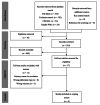Scoping Review of Virtual Reality (VR)-Based Disaster Mitigation Education
- PMID: 39712731
- PMCID: PMC11659903
- DOI: 10.7759/cureus.74062
Scoping Review of Virtual Reality (VR)-Based Disaster Mitigation Education
Abstract
This study explored the use of virtual reality (VR) in disaster preparedness education, focusing on VR scenarios, disaster types, and user interactivity to identify gaps in existing research. A scoping review methodology, based on the Arksey and O'Malley framework and Preferred Reporting Items for Systematic Reviews and Meta-Analyses-Scoping Reviews (PRISMA-ScR) guidelines, was used, and the protocols were registered in the UMIN Clinical Trials Registry (UMIN000052800). The review included PubMed, CINAHL, the Cochrane Central Register of Controlled Trials in the Cochrane Library, and Ichushi-Web of the Japan Medical Abstract Society, with data up to January 31, 2024. Studies on disaster preparedness and mitigation education using VR were included, without restrictions on study design, country, or language. We excluded studies utilizing non-immersive VR, as well as non-academic letters to the editor, editorials, commentaries, review articles, conference abstracts, and non-academic manuscripts. In the first screening phase, 2 researchers independently reviewed the titles and abstracts of 516 articles and conducted the screening. A total of 17 articles were selected. In cases where there were differing opinions on inclusion or exclusion, the two researchers discussed the matter together. In the second screening phase, the 17 selected articles underwent full-text screening. Three articles were excluded because their outcomes did not align with our research. Eight articles were excluded based on our predefined criteria, which included commentaries, editorials, and review articles. Ultimately, six articles were included in the meta-analysis. Of these, three studies were from East Asia, one from Australia, one from North America, and one from an unspecified region. Disaster types included chemical, radiation, explosion, fire, and earthquake events. The VR training scenarios covered evacuation, first aid, patient transport, triage, decontamination, and other skills. Five of the studies emphasized user interactivity and were primarily aimed at professionals such as medical staff and nursing students. Current VR disaster response training primarily targets professionals, demonstrating its effectiveness and importance; however, there is a lack of studies focusing on training for the general public, especially in the least developed countries. Extending VR-based training programs to the general public is critical to improving countries' disaster response capabilities.
Keywords: disaster; education; learning; mass casualty incidents; virtual reality.
Copyright © 2024, Kimura et al.
Conflict of interest statement
Conflicts of interest: In compliance with the ICMJE uniform disclosure form, all authors declare the following: Payment/services info: This research was funded by the Japanese Red Cross Kyushu International College of Nursing Incentive Research (Task No. 23-3). Funding for this study was provided by unrestricted grants from NEW NURSING, Inc. (grant number: N/A). The funding source had no role in the design, practice, or analysis of this study. Financial relationships: All authors have declared that they have no financial relationships at present or within the previous three years with any organizations that might have an interest in the submitted work. Other relationships: All authors have declared that there are no other relationships or activities that could appear to have influenced the submitted work.
Figures
Similar articles
-
Beyond the black stump: rapid reviews of health research issues affecting regional, rural and remote Australia.Med J Aust. 2020 Dec;213 Suppl 11:S3-S32.e1. doi: 10.5694/mja2.50881. Med J Aust. 2020. PMID: 33314144
-
Virtual Reality for Developing Patient-Facing Communication Skills in Medical and Graduate Education: Protocol for a Scoping Review.JMIR Res Protoc. 2024 Feb 1;13:e53901. doi: 10.2196/53901. JMIR Res Protoc. 2024. PMID: 38300671 Free PMC article.
-
Virtual Reality and Augmented Reality Training in Disaster Medicine Courses for Students in Nursing: A Scoping Review of Adoptable Tools.Behav Sci (Basel). 2023 Jul 24;13(7):616. doi: 10.3390/bs13070616. Behav Sci (Basel). 2023. PMID: 37504063 Free PMC article.
-
Virtual Reality in Medical Students' Education: Scoping Review.JMIR Med Educ. 2022 Feb 2;8(1):e34860. doi: 10.2196/34860. JMIR Med Educ. 2022. PMID: 35107421 Free PMC article.
-
Mixed Reality Platforms in Telehealth Delivery: Scoping Review.JMIR Biomed Eng. 2023 Mar 24;8:e42709. doi: 10.2196/42709. JMIR Biomed Eng. 2023. PMID: 38875694 Free PMC article.
References
-
- Ritchie H, Rosado P. Natural disasters. Our World in Data. Natural Disasters. Published online at OurWorldinData.org. [ Apr; 2024 ]. 2022. https://ourworldindata.org/natural-disasters https://ourworldindata.org/natural-disasters
-
- Principles and practice of disaster relief: lessons from Haiti. Benjamin E, Bassily-Marcus AM, Babu E, Silver L, Martin ML. Mt Sinai J Med. 2011;78:306–318. - PubMed
-
- Natural disasters in developing countries: mental health issues. Kar N. https://pubmed.ncbi.nlm.nih.gov/19770522/ Ind J Med Sci. 2009;63:327–329. - PubMed
-
- The 2024 Noto Peninsula earthquake and the strategy of medical assistance from the Tohoku University Hospital. Egawa S, Ishii T, Furukawa H, et al. Tohoku J Exp Med. 2024;262:45–49. - PubMed
-
- U.S. geological survey. Significant earthquakes - 2024. [ Apr; 2024 ]. 2024. https://earthquake.usgs.gov/earthquakes/browse/significant.php https://earthquake.usgs.gov/earthquakes/browse/significant.php
Publication types
LinkOut - more resources
Full Text Sources

